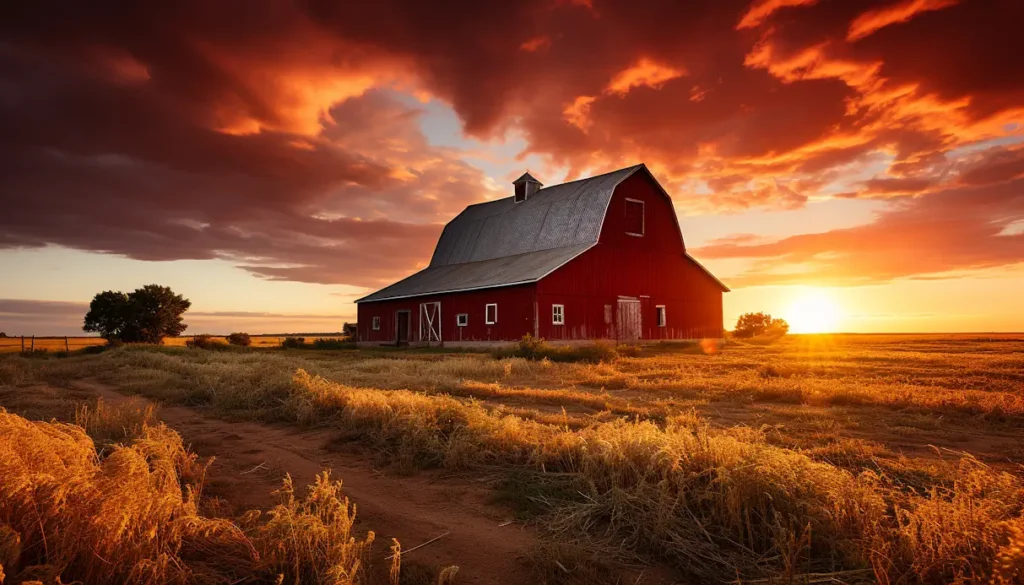Barns are an iconic part of the American landscape, each with its own unique design and purpose. From the classic red gambrel barns to the modern prefabricated structures, barns have evolved to meet the needs of farmers and ranchers across the country. In this article, we will explore the various types of barns found in the USA and provide tips on how to distinguish between them.

Gambrel Barns
Gambrel barns are perhaps the most recognizable type of barn in the United States. Characterized by their distinctive double-sloped roof, these barns offer ample storage space in the upper loft area. The gambrel roof design allows for more headroom and storage capacity compared to a traditional gable roof. These barns are often painted red, a color that has become synonymous with American barns. For more information on traditional barn designs, visit the National Park Service.
Bank Barns
Bank barns are unique in that they are built into a hillside or bank. This design allows for easy access to both the upper and lower levels of the barn. The lower level is typically used for housing livestock, while the upper level is used for storing hay and grain. The natural insulation provided by the earth helps maintain a stable temperature inside the barn, making it ideal for livestock.
Monitor Barns
Monitor barns, also known as raised-roof barns, feature a raised center section with its own roof. This design allows for additional ventilation and natural light, making it a popular choice for housing livestock. The raised center section often includes windows or vents, which help improve air circulation and reduce the buildup of heat and moisture. For further details on barn ventilation, check out the University of Minnesota Extension.
Pole Barns
Pole barns are a modern and cost-effective option for farmers. These barns are constructed using poles or posts buried in the ground, which serve as the main support structure. The walls and roof are then attached to these poles. Pole barns are highly versatile and can be used for a variety of purposes, including housing livestock, storing equipment, and even as workshops. For more on pole barn construction, visit the USDA.
Dutch Barns
Dutch barns are known for their broad, sweeping roofs that extend almost to the ground. This design provides excellent protection from the elements and maximizes storage space. Dutch barns are often used for storing hay and grain, as well as housing livestock. The unique roof design also helps shed snow and rain, making it ideal for regions with harsh weather conditions. More information can be found at the Library of Congress.
Round Barns
Round barns, as the name suggests, are circular in shape. This design was popular in the late 19th and early 20th centuries due to its efficiency and ease of construction. The circular shape allows for a central feeding area, with livestock stalls arranged around the perimeter. This design also provides excellent structural stability and can withstand strong winds.
English Barns
English barns are one of the oldest types of barns in the United States. These barns have a simple rectangular design with a gable roof. The main entrance is typically located on the long side of the barn, and the interior is divided into sections for storing hay, grain, and livestock. English barns are often made from timber and have a rustic, traditional appearance.
Tobacco Barns
Tobacco barns are specifically designed for drying and curing tobacco leaves. These barns have tall, narrow structures with multiple levels of ventilation to allow for proper air circulation. The walls of tobacco barns often have adjustable vents or slats that can be opened or closed to control the drying process. These barns are commonly found in regions where tobacco farming is prevalent. For more on tobacco barns, visit North Carolina State University.
Corn Crib Barns
Corn crib barns are designed for storing and drying corn. These barns have open sides or slatted walls to allow for maximum airflow, which helps prevent mold and spoilage. Corn crib barns often have a central aisle for easy access to the stored corn, and the structure is elevated off the ground to protect the corn from pests.
Horse Barns
Horse barns, also known as stables, are specifically designed for housing horses. These barns typically have individual stalls for each horse, as well as areas for storing feed, tack, and equipment. Horse barns often include features such as wash stalls, grooming areas, and riding arenas. The design of horse barns prioritizes the comfort and safety of the horses.
How to Identify Different Types of Barns
Identifying different types of barns can be a fun and educational experience. Here are some tips to help you distinguish between them:
- Roof Design: The shape and style of the roof can provide clues about the type of barn. For example, gambrel barns have a double-sloped roof, while monitor barns have a raised center section.
- Construction Materials: The materials used in the construction of the barn can also be a giveaway. Traditional barns are often made from timber, while modern barns may use metal or prefabricated materials.
- Purpose: Consider the primary use of the barn. Is it designed for housing livestock, storing crops, or drying tobacco? The intended purpose can help narrow down the type of barn.
- Location: The region where the barn is located can also provide hints. Certain types of barns are more common in specific areas due to climate and agricultural practices.
Conclusion
Barns are an integral part of America’s agricultural heritage, each with its own unique design and function. Whether you’re a farmer looking to build a new barn or simply a barn enthusiast, understanding the different types of barns and their characteristics can enhance your appreciation for these iconic structures. By paying attention to details such as roof design, construction materials, and purpose, you can easily identify and differentiate between the various types of barns found across the United States.

